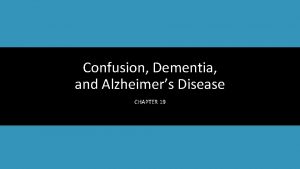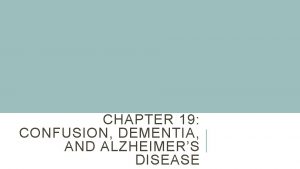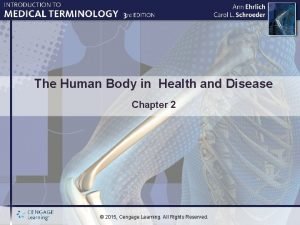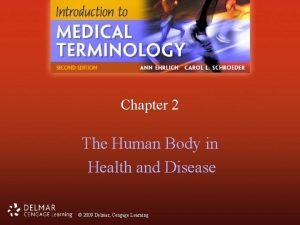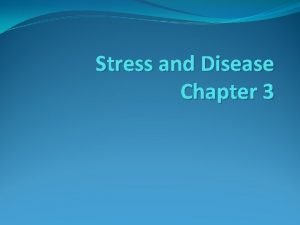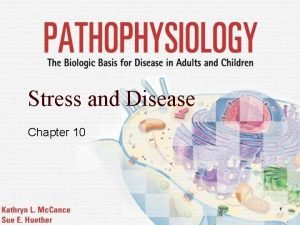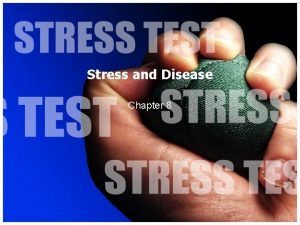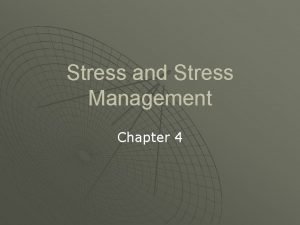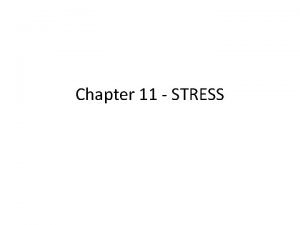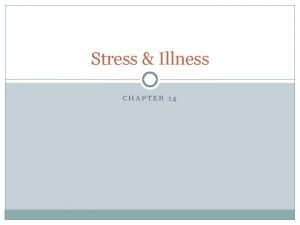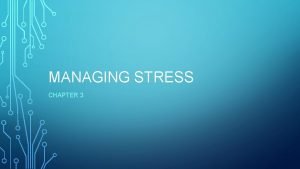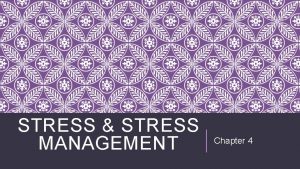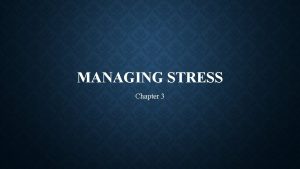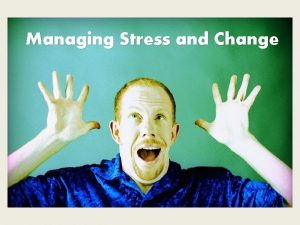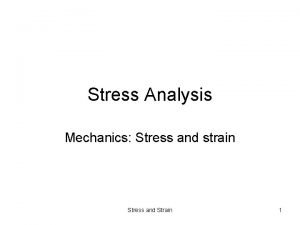Stress and Disease Chapter 10 1 Stress o
















- Slides: 16

Stress and Disease Chapter 10 1

Stress o o o A person experiences stress when a demand exceeds a person’s coping abilities, resulting in reactions such as disturbances of cognition, emotion, and behavior that can adversely affect well-being General Adaptation Syndrome (GAS)-response to stressors Three stages n Alarm stage o n Stage of resistance or adaptation o n Arousal of body defenses Mobilization contributes to fight or flight Stage of exhaustion o Progressive breakdown of compensatory mechanisms 2 Mosby items and derived items © 2006 by Mosby, Inc.

GAS Activation o Alarm stage n Stressor triggers the hypothalamic-pituitaryadrenal (HPA) axis o o Resistance stage n o Activates sympathetic nervous system Begins with the actions of adrenal hormones Exhaustion stage n Occurs only if stress continues and adaptation is not successful 3 Mosby items and derived items © 2006 by Mosby, Inc.

Psychoneuroimmunologic Mediators o o Interactions of consciousness, the brain and spinal cord, and the body’s defense mechanisms Corticotropin-releasing hormone (CRH) is released from the hypothalamus CRH is also released peripherally at inflammatory sites Immune modulation by psychosocial stressors leads directly to health outcomes 4 Mosby items and derived items © 2006 by Mosby, Inc.

Central Stress Response o Catecholamines n Released from chromaffin cells of the adrenal medulla o n α-adrenergic receptors o n α 1 and α 2 β-adrenergic receptors o n Large amounts of epinephrine; small amounts of norepinephrine β 1 and β 2 Mimic direct sympathetic stimulation 5 Mosby items and derived items © 2006 by Mosby, Inc.

Central Stress Response o Cortisol (hydrocortisone) n n n Activated by adrenocorticotropic hormone (ACTH) Stimulates gluconeogenesis Elevates the blood glucose level Protein anabolic effect in the liver; catabolic effect in other tissues Lipolytic in some areas of the body, lipogenic in others Powerful anti-inflammatory/immunosuppressive agent 6 Mosby items and derived items © 2006 by Mosby, Inc.

Central Stress Response 7 Mosby items and derived items © 2006 by Mosby, Inc.

Central Stress Response 8 Mosby items and derived items © 2006 by Mosby, Inc.

Stress-Induced Hormone Alterations o Female reproductive system n n n Cortisol exerts inhibiting effects by suppressing the release of luteinizing hormone, estradiol, and progesterone Stress suppresses hypothalamic gonadotropinreleasing hormone Estrogen stimulates the HPA axis 9 Mosby items and derived items © 2006 by Mosby, Inc.

Stress-Induced Hormone Alterations o Endorphins and enkephalins n n Proteins found in the brain that have painrelieving capabilities In a number of conditions, individuals not only experience insensitivity to pain but also increased feelings of excitement, positive well-being, and euphoria 10 Mosby items and derived items © 2006 by Mosby, Inc.

Stress-Induced Hormone Alterations o Growth hormone (somatotropin) n n n Produced by the anterior pituitary and by lymphocytes and mononuclear phagocytic cells Affects protein, lipid, and carbohydrate metabolism and counters the effects of insulin Enhances immune function 11 Mosby items and derived items © 2006 by Mosby, Inc.

Stress-Induced Hormone Alterations o Prolactin n o Released from the anterior pituitary Necessary for lactation and breast development Prolactin levels in the plasma increase as a result of stressful stimuli Oxytocin n Produced by the hypothalamus Produced during orgasm in both sexes May promote reduced anxiety 12 Mosby items and derived items © 2006 by Mosby, Inc.

Stress-Induced Hormone Alterations o Testosterone n n n Secreted by Leydig cells Regulates male secondary sex characteristics and libido Testosterone levels decrease due to stressful stimuli 13 Mosby items and derived items © 2006 by Mosby, Inc.

Stress, Personality, Coping, and Illness o o A stressor for one person may not be a stressor for another Psychologic distress n o General state of unpleasant arousal after life events that manifests as physiologic, emotional, cognitive, and behavior changes Coping n Managing stressful demands and challenges that are appraised as taxing or exceeding the resources of the person 14 Mosby items and derived items © 2006 by Mosby, Inc.

Stress, Personality, Coping, and Illness 15 Mosby items and derived items © 2006 by Mosby, Inc.

Aging and Stress o Stress-age syndrome n n n n Excitability changes in the limbic system and hypothalamus Increased catecholamines, ADH, ACTH, and cortisol Decreased testosterone, thyroxine, and other hormones Alterations of opioid peptides Immunodepression Alterations in lipoproteins Hypercoagulation of the blood Free radical damage of cells 16 Mosby items and derived items © 2006 by Mosby, Inc.
 Communicable disease and non communicable disease
Communicable disease and non communicable disease Chapter 10 stress responses and stress management
Chapter 10 stress responses and stress management True stress vs engineering stress
True stress vs engineering stress Normal stress definition
Normal stress definition Chapter 35 immune system and disease
Chapter 35 immune system and disease Chapter 19 disease transmission and infection prevention
Chapter 19 disease transmission and infection prevention Confusion dementia and alzheimer disease chapter 19
Confusion dementia and alzheimer disease chapter 19 Chapter 26 infectious disease prevention and control
Chapter 26 infectious disease prevention and control Chapter 19 disease transmission and infection prevention
Chapter 19 disease transmission and infection prevention Chapter 19 confusion dementia and alzheimer's disease
Chapter 19 confusion dementia and alzheimer's disease Chapter 19 confusion dementia and alzheimer's disease
Chapter 19 confusion dementia and alzheimer's disease Chapter 19 disease transmission and infection prevention
Chapter 19 disease transmission and infection prevention The human body in health and disease chapter 2 answer key
The human body in health and disease chapter 2 answer key The human body in health and disease chapter 2 answer key
The human body in health and disease chapter 2 answer key Adenomalacia is the abnormal hardening of a gland.
Adenomalacia is the abnormal hardening of a gland. Chapter 8 managing stress and anxiety
Chapter 8 managing stress and anxiety Chapter 4 managing stress and coping with loss
Chapter 4 managing stress and coping with loss






